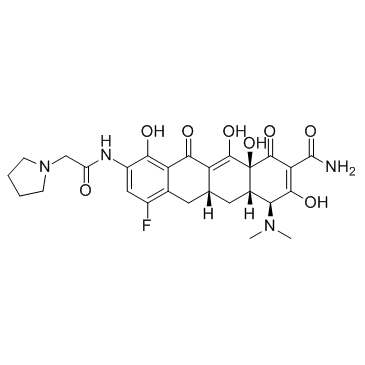1207283-85-9
| Name | (4S,4aS,5aR,12aR)-4-(dimethylamino)-7-fluoro-1,10,11,12a-tetrahydroxy-3,12-dioxo-9-[(2-pyrrolidin-1-ylacetyl)amino]-4a,5,5a,6-tetrahydro-4H-tetracene-2-carboxamide |
|---|---|
| Synonyms |
(4S,4aS,5aR,12aS)-4-(Dimethylamino)-7-fluoro-3,10,12,12a-tetrahydroxy-1,11-dioxo-9-[(1-pyrrolidinylacetyl)amino]-1,4,4a,5,5a,6,11,12a-octahydro-2-tetracenecarboxamide
eravacycline TP-434 1-Pyrrolidineacetamide, N-[(5aR,6aS,7S,10aS)-9-(aminocarbonyl)-7-(dimethylamino)-4-fluoro-5,5a,6,6a,7,10,10a,12-octahydro-1,8,10a,11-tetrahydroxy-10,12-dioxo-2-naphthacenyl]- |
| Description | Eravacycline is a potent and broad-spectrum antibacterial agent. |
|---|---|
| Related Catalog | |
| Target |
Antibacterial[1] |
| In Vitro | Eravacycline is potent antibiotic against A. baumannii, including isolates that are resistant to sulbactam, imipenem/meropenem, levofloxacin, and amikacin/tobramycin. Eravacycline shows greater activity than the comparators of the tetracycline class, levofloxacin, amikacin, tobramycin, and colistin. The eravacycline MIC50/90 values are 0.5/1 mg/L[1]. Eravacycline shows inhibitory effects on six E. coli with MICs ranging from 0.125 to 0.25 mg/L[2]. Eravacycline dihydrochloride is a synthetic antibiotic, with inhibits bacterial protein synthesis through binding to the 30S ribosomal subunit. Eravacycline displays broad spectrum activity against gram-negative bacteria in the panel except P. aeruginosa, as well as excellent activity against major gram-positive pathogens, including methicillin-resistant S. aureus. Eravacycline also displays potent ribosomal inhibition[3]. Eravacycline shows potent broad-spectrum activity against 90% of the isolates (MIC90) in each panel at concentrations ranging from ≤0.008 to 2 μg/mL for all species panels except those of Pseudomonas aeruginosa and Burkholderia cenocepacia (MIC90 values of 32 μg/mL for both organisms). Eravacycline is active against multidrug-resistant bacteria, including those expressing extended-spectrum β-lactamases and mechanisms conferring resistance to other classes of antibiotics, including carbapenem resistance[4]. |
| In Vivo | Mice are treated with two-fold increasing doses (range 3.125 to 50 mg/kg) of eravacycline every 12 hours. The mean fAUC/MIC magnitude associated with net stasis and 1-log kill endpoint are 27.97±8.29 and 32.60±10.85, respectively[2]. Eravacycline is active in multiple murine models of infection against clinically important Gram-positive and Gram-negative pathogens. Eravacycline is efficacious in mouse septicemia models, demonstrating 50% protective dose values of ≤1 mg/kg of body weight once a day (q.d.) against Staphylococcus aureus, including tetracycline-resistant isolates of methicillin-resistant S. aureus (MRSA), and Streptococcus pyogenes. The PD50 values against Escherichia coli isolates are 1.2 to 4.4 mg/kg q.d[5]. |
| Animal Admin | Rats[3] Pharmacokinetic (PK) parameters are determined in Sprague−Dawley rats. Animals are fasted overnight (minimum of 12 h) and given a single oral (10 mg/kg) or IV dose (1 mg/kg) of eravacycline followed by a sampling scheme for 24 h. Plasma and dosing solution concentrations are determined by TurboIonspray LC/MSMS analysis using appropriate standard curves. PK parameters are calculated by noncompartmental analysis. Mice[5] Eravacycline is formulated in sterile 0.9% saline. BALB/c mice are inoculated with 0.2 mL of prepared bacterial inoculum via intravenous injection to seed the kidney. Animals are administered antibiotics (eravacycline) at 10 mL/kg i.v. via the tail vein 12 and 24 h postinfection. Then the bacterial burden is determined. |
| References |
| Density | 1.6±0.1 g/cm3 |
|---|---|
| Boiling Point | 868.1±65.0 °C at 760 mmHg |
| Molecular Formula | C27H31FN4O8 |
| Molecular Weight | 558.555 |
| Flash Point | 478.8±34.3 °C |
| Exact Mass | 558.212585 |
| PSA | 198.21000 |
| LogP | 0.25 |
| Vapour Pressure | 0.0±0.3 mmHg at 25°C |
| Index of Refraction | 1.711 |
